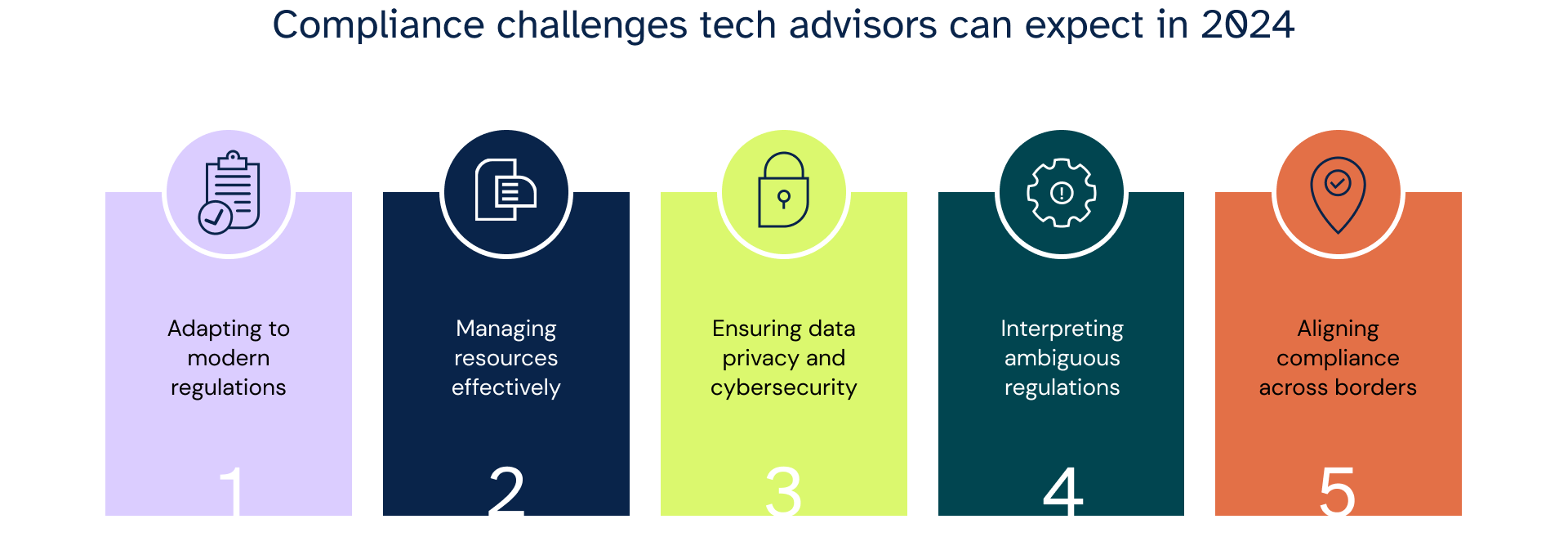
As technology evolves rapidly, advisors must stay vigilant in meeting compliance standards that govern their operations and protect client data. In 2024, a few key challenges will likely persist.
In the following sections, we'll delve deep into specific compliance challenges tech advisors can expect in 2024, equipping you with strategies and insights to overcome them. Join us as we explore:
- Adapting to modern regulations: Keeping up with the rapid evolution of regulatory landscapes and interpretations.
- Managing resources effectively: Maximizing efficiency and ensuring your team has the tools and expertise to handle complex compliance tasks.
- Ensuring data privacy and cybersecurity: Safeguarding client information in a world fraught with evolving threats and rising data privacy concerns.
- Interpreting ambiguous regulations: Deciphering vague terminology and conflicting interpretations to ensure your clients remain compliant.
- Aligning compliance across borders: Bridging the compliance gap for clients with global operations and diverse regulatory requirements.

Adapting to the modern regulatory landscape
Adapting to the modern regulatory landscape is about more than just keeping up with the latest changes. It's about developing a mindset and skill set that allows you to navigate rapid developments, anticipate regulatory shifts, and guide your clients to compliance with agility and grace.
Here are some of the key challenges tech advisors face in adapting to the modern regulatory landscape:
- The pace of change: Regulations don't follow a predictable release schedule. They can emerge overnight, triggered by technological advancements, data breaches, or political winds. Staying informed through diverse sources, from industry publications to government alerts, is crucial.
- The regulatory differences: The global regulatory landscape is a tangled web of jurisdictions, each with its rules and requirements. Understanding the interplay between local, national, and international regulations is essential for crafting effective compliance strategies.
- The tech-regulation gap: Technology often outpaces regulation, leaving advisors grappling with gray areas and ambiguous interpretations. Staying abreast of emerging technologies and their regulatory implications is key to advising clients proactively.
- The resource problem: Adapting to change requires resources — time, budget, and workforce. Prioritizing initiatives based on potential impact and risk, leveraging automation tools, and seeking external expertise can help you stretch your resources effectively.
Tech advisors can help their clients thrive in this dynamic regulatory environment through these strategies:
- Embrace continuous learning: Invest in training and development programs for yourself and your team to stay ahead of the curve on new regulations and technologies.
- Foster a culture of agility: Encourage a flexible and adaptable mindset within your organization, where rapid response and course correction are celebrated.
- Leverage technology: Utilize GRC software solutions that automate routine tasks, track regulatory changes, and provide real-time compliance insights.
- Build a strong network: Connect with industry peers, regulatory bodies, and legal experts to share knowledge, stay informed, and access diverse perspectives.
Managing resources effectively
Balancing compliance initiatives, mitigating security risks, and complying with diverse changing regulations while optimizing resources can be challenging. In 2024, this challenge takes on a new level of complexity, making effective resource management more crucial than ever.
The tech landscape is facing various challenges in managing resources:
- Sprawling IT infrastructure: Modern tech ecosystems are intricate tapestries of interconnected systems, applications, and data. Mapping this labyrinthine terrain and deploying GRC controls effectively across its expanse demands strategic allocation of resources.
- Limited talent: Finding skilled and qualified GRC professionals is tough, and retention is even harder. This scarcity makes efficient utilization of existing talent paramount to maximizing its impact.
- Budgetary constraints: GRC tools and initiatives come at a cost, competing with other business priorities for a slice of the pie. Advisors must demonstrate the tangible value of GRC investments to secure necessary resources.
- Data deluge: The sheer volume of data generated by IT systems also contributes to increasingly tight resources. Analyzing, monitoring, and securing this ever-growing data ocean requires innovative solutions for optimized resource utilization.
For effective resource management, tech advisors can:
- Embrace automation: Leverage GRC software solutions that automate routine tasks like data collection, reporting, and risk assessments. That frees up valuable human resources for higher-level strategic activities.
- Prioritize effectively: Implement risk-based approaches to prioritize GRC initiatives based on potential impact and likelihood of occurrence. Focusing on the most critical issues allows for efficient allocation of resources.
- Upskill existing talent: Invest in training and development programs for your team to build their GRC expertise. A skilled and adaptable workforce can handle diverse tasks and maximize their contributions.
- Outsource strategically: For specific tasks or expertise gaps, consider outsourcing to specialized GRC providers. That allows you to tap into external resources without significant internal resource expenditures.
- Embrace collaboration: Foster a culture of collaboration between IT, security, and business teams. By working together, teams can share resources, leverage collective expertise, and optimize project outcomes.
Ensuring data privacy and cybersecurity
In the digital age, data reigns supreme. That said, data breaches and privacy violations are increasingly becoming more common. For tech advisors, ensuring data privacy and cybersecurity is an ongoing battle against emerging threats, with several key hurdles to overcome:
- The shifting regulations: The regulatory landscape for data privacy and cybersecurity is constantly evolving. New laws like the California Consumer Privacy Act (CCPA) and the General Data Protection Regulation (GDPR) raise the bar for data protection, while stricter enforcement by agencies like the FTC keeps businesses on their toes. Keeping up with these changes and ensuring compliance across jurisdictions is complex, requiring advisors to be agile and informed.
- The rise of advanced threats: Cybercriminals are not standing still. Sophisticated attacks like ransomware and zero-day exploits are becoming increasingly common, demanding robust security measures. Advisors must stay ahead of the curve by implementing multi-layered security solutions, including vulnerability management, intrusion detection, and incident response protocols.
- The explosion of data: The amount of data generated and stored is increasing exponentially, making it difficult to manage and protect effectively. Advisors must find innovative ways to classify data, prioritize its protection based on sensitivity, and implement robust data loss prevention measures.
- The cloud problem: Cloud computing offers numerous benefits but introduces new security challenges. Advisors must ensure their clients understand the shared responsibility model of cloud security, choose reputable cloud providers with robust security practices, and implement appropriate access controls and encryption mechanisms.
- The human factor: The weakest link in any security chain is often the human element. Phishing attacks, social engineering, and insider threats are still prevalent, requiring advisors to prioritize employee training and awareness programs to foster an organization's security culture.
Tech advisors can help their clients address these challenges and build a secure data citadel through these strategic recommendations:
- Embrace a comprehensive GRC approach: GRC provides a holistic framework for managing data privacy and cybersecurity risks. Implementing a GRC software solution can automate tasks, streamline compliance efforts, and provide real-time insights into potential threats.
- Partner with experienced security professionals: Seek the expertise of seasoned cybersecurity professionals who can assess your client's specific needs, develop customized security strategies, and provide ongoing support.
- Invest in continuous training and education: Regular training programs for employees on data privacy and cybersecurity best practices can significantly reduce the risk of human error and insider threats.
- Stay informed about the latest threats and regulations: Subscribe to industry publications, attend conferences, and engage with security communities to stay ahead of the curve and adapt your strategies accordingly.
Interpreting ambiguous regulations
Interpreting ambiguous regulations is another huge challenge tech advisors face. That is particularly true for emerging tech like AI and blockchain, where laws are still evolving, and the regulatory framework is often lagging.
Consider the case of the California Consumer Privacy Act (CCPA). While it grants consumers control over their personal data, key terms like "personal information" and "sale" remain open to interpretation. This ambiguity leaves tech companies in a gray area, unsure if their practices comply.
The consequences of misinterpreting ambiguous regulations can be dire. Fines, reputational damage, and even legal action can occur if companies are deemed non-compliant. The pressure is on tech advisors to interpret ambiguous regulations and ensure their clients confidently comply.
So, how can tech advisors interpret ambiguous regulations?
- Seek expert guidance: Experts can provide tech advisors with a comprehensive understanding of the different possible interpretations of an ambiguous regulation and the potential consequences of each. That allows advisors to make informed decisions about how to advise their clients in a way that protects their interests.
- Engage with regulators: Don't be afraid to reach out to regulatory bodies for clarification. Many agencies offer guidance documents and public forums to address industry concerns.
- Stay informed: Keep abreast of the latest regulatory developments and interpretations. Industry publications, legal blogs, and attendance at relevant conferences can be invaluable resources.
- Adopt a risk-based approach: A risk-based approach allows advisors and their clients to prioritize regulations based on the potential severity of their consequences. That means focusing on regulations presenting the highest risk of causing harm (financial, reputational, legal) if not interpreted and complied with correctly. This allocation of resources ensures efficient use of time and expertise.
Aligning compliance across borders
As businesses expand their reach and data flows freely across national boundaries, ensuring adherence to a patchwork of diverse regulatory frameworks becomes a logistical and legal challenge.
That stems from the fragmented nature of global regulatory efforts. While some regions, like the European Union, have established comprehensive data privacy and security frameworks like the General Data Protection Regulation (GDPR), others lack such robust legislation.
That creates a scenario where a single tech solution might need to comply with a kaleidoscope of often-contradictory regulations.
Let's take Acme Tech, a US-based software company, as an example. They developed a popular cloud-based productivity app used by businesses worldwide. To attract more European customers, they decided to open a data center in Germany. That introduced numerous compliance challenges:
- Data Privacy: The EU's General Data Protection Regulation (GDPR) imposes strict rules on collecting, storing, and using personal data. Acme Tech must ensure its app complies with GDPR, regardless of its user's location, which may involve obtaining informed consent, providing data subject rights, and implementing robust security measures.
- Data Localization: Some countries, like Germany, have data localization laws requiring specific types of data (e.g., financial data) to be stored within their borders. Acme Tech needs to determine whether their app collects such data and, if so, how to store it in the German data center while complying with other regulations, such as GDPR's right to transfer data from the EU.
- Cybersecurity: Different countries have their cybersecurity regulations and standards. Acme Tech must understand and comply with German data center and security practices requirements while ensuring their global infrastructure adheres to broader international cybersecurity frameworks.
- Export Controls: If Acme Tech's app contains certain technologies or encryption algorithms, exporting it to certain countries outside the EU may be subject to export controls. They must classify their technology, assess export restrictions, and obtain necessary licenses to avoid legal ramifications.
Acme Tech is just one example, highlighting the challenge of aligning compliance across borders. Each regulation interacts with others, creating a tapestry of requirements that technology advisors must navigate seamlessly.
Expert guidance can help advisors unravel this complexity, ensuring their clients comply with all relevant regulations, protect user data, and avoid costly consequences.
The consequences of non-compliance are far-reaching and potentially crippling. Hefty fines, reputational damage, and even market access restrictions can all be levied against companies found wanting in their cross-border compliance efforts.
Tech advisors can overcome this challenge through the following:
- Stay informed: Proactive monitoring of regulatory changes is crucial. Subscribe to industry publications and government alerts to stay ahead.
- Conduct compliance audits: Regularly assess your solutions against relevant regulations to identify potential gaps and implement corrective measures.
- Seek expert guidance: Legal systems worldwide are diverse, with different approaches to data privacy, cybersecurity, intellectual property, and other relevant areas. Advisors must understand these differences and ensure their clients' technology complies with all applicable laws in each relevant jurisdiction.
- Embrace technology: Leverage GRC software solutions to streamline compliance efforts and automate data mapping and reporting tasks.
Achieve innovation and sustainable growth
Technology advisors like you are critical in empowering businesses to thrive in a world increasingly governed by regulations. By embracing the challenges, leveraging the right tools, and fostering a culture of continuous improvement, you can become the trusted guides your clients need in managing regulatory compliance with confidence and agility.
Remember, compliance is a continuous endeavor. By embracing this mindset and adopting the discussed strategies, you can transform compliance from a burden to a strategic advantage, enabling your clients to innovate, grow, and achieve their business goals in a world of constant change.

